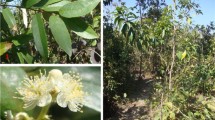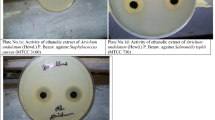Abstract
Objective
To evaluate the antimicrobial activity of the methanol extract from the stem bark of Drypetes tessmanniana, fractions (DTB1-5) as well as compounds [friedelin (2), 3,7-dioxofriedelane (3), 3,15-dioxofriedelane (4), 3β- O-(E)-3,5-dihydroxycinnamoyl-11-oxo-olean-12-ene (6), and 3β,6α-dihydroxylup-20(29)-ene (7).
Methods
Agar disc diffusion was used to determine the sensitivity of the above samples, whilst the microdilution method was used for the determination of the minimal inhibitory concentration (MIC) and the minimal microbicidal concentrations (MMC).
Results
The diffusion test showed that the crude extract was able to prevent the growth of all tested organisms. All other samples showed selective activity. The inhibitory effect of the fraction DTB2 was noted on 63.7%, that of DTB1 and DBT3 on 54.6%, whilst DTB4 and DTB5 were active on 9.1% of the 11 tested organisms. The tested compounds prevented the growth of 81.8% of the tested microbial species for compounds 3 and 4, 36.7% for compound 6, and 18.2% for compound 7. The results of the MIC determinations indicated perceptible values for DTB and compound 4 on 81.8% of the tested organisms. For other samples, MICs were detected on 0–63.7%. The lowest MIC value (78.12 μg/mL) for the crude extract and fractions (DTB2) was observed on M. audouinii. The corresponding value for isolated compounds (156.25 μg/mL) was noted with compounds 3 on S. faecalis and 4 on M. audouinii audouinii. The results of the MMC determination suggested that the microbicidal effect of most of the tested samples on the studied microorganisms could be expected.
Conclusion
The methanol extract from the stem bark of Drypetes. tessmanniana (Euphorbiaceae) as well as some of the isolated compounds might be potential sources of new antimicrobial drugs.
Similar content being viewed by others
References
Phillipson JD. Phytochemistry and medicinal plants. Phytochemistry 2001;56:237–243.
Newman DJ, Cragg GM. Natural products as source of new drugs over last 25 years. J Nat Prod 2007;70:461–477.
World Health Organisation. WHO guideline for the assessment of herbal medicines, WHO expert committee on specification for pharmaceutical preparation. Technical report series No. 863. Geneva:1996.
Dalziel JM. The useful plants of west tropical Africa. London: The Crown Agents for the Colonies;1937:140–141.
Irvine RF. Woody plant of Ghana. London: Oxford University Press;1961: 223–226.
Walker AR, Sillans R, Trochain JL. The medicinal plants of Gabon. Paris: Paul Lechevalier: 1961:165–166.
Bouquet A, Debray L. The medicinal plants of Ivory Cost. Paris: Work and Documents of No.32; 1974:82–87.
Mahato SB, Kundu AP. 13C NMR spectra of pentacyclic triterpenoids. A compilation and some salient features. Phytochemistry 1994;37:1517–1575.
Chungag-Anye NB, Njamen D, Dongmo AB, Fomum ZT, Dongmo A, Nguefack T, et al. Anti-inflammatory and analgesic effects of drypemolundein A, a sesquiterpene lactone from Drypetes molunduana. Pharmaceut Biol 2002;41:26–30.
Wandji J, Tillequin F, Mulholland AD, Temgoua AD, Wansi JD, Seguin E, et al. Phenolic constituents from Drypetes armoracia. Phytochemistry 2003;63:453–456.
Dongfack JDM, Van-Dufat TH, Lallemand MC, Wansi JD, Seguin E, Tillequin F, et al. New triterpenoids from the stem bark of Drypetes tessmanniana. Chem Pharm Bull 2008;56:1321–1323.
Mbaveng AT, Ngameni B, Kuete V, Simo IK, Ambassa P, Roy R, et al. Antimicrobial activity of the crude extracts and five flavonoids from the twigs of Dorstenia barteri (Moraceae). J Ethnopharmacol 2008;116:483–489.
Kuete V, Konga SI, Ngameni B, Bigoga JD, Watchueng P, Nzesse KR, et al. Antimicrobial activity of the methanolic extract, fractions and four flavonoids from the twigs of Dorstenia angusticornis Engl (Moraceae). J Ethnopharmacol 2007;112: 271–277.
Kuete V, Ngameni B, Mbaveng TA, Ambassa AM, Simo KI, Bezabih A, al. Antimicrobial activity of the extract from the twigs of Dorstenia elliptica (Moraceae). Pharmacologyonline 2007;1:573–580.
Kuete V, Metuno R, Ngameni B. Antimicrobial activity of the methanolic extracts and compounds from Treculia obovoidea (Moraceae). J Ethnopharmacol 2007;112:531–536.
Kuete V, Eyong KO, Folefoc GN, Beng VP, Hussain H, Krohn K, et al. Antimicrobial activity of the methanolic extract and of chemical constituents isolated from Newbouldia laevis. Pharmazie 2007;62:552–556.
Kuete V, Mbaveng TA, Tsafack M, Beng VP, Etoa FX, Nkengfack AE, et al. Antitumor, antioxidant and antimicrobial activities of Bersama engleriana (Melianthaceae). J Ethnopharmacol 2008;115:494–501.
Carbonnelle B, Denis F, Marmonier A, Pinon G, Vague R, eds. Medical bacteriology: common techniques. Paris: SIMEP;1987:228–282.
Tereschuck ML, Riera MVQ, Castro GR, Abdala LR. Antimicrobial activity of flavonoids from leaves of Tagetes minuta. J Ethnopharmacol 1997;56:227–232.
More G, Tshikalange TE, Lall N, Botha F, Meyer JJ. Antimicrobial activity of medicinal plants against oral microorganisms. J Ethnopharmacol 2008;119: 473–477.
Mims CA, Playfair JHL, Roitt IM, Wakelin D, Williams R. Antimicrobials and chemotherapy. In: Mims CA, eds. Med Microbiol Rev 1993;35:1–34.
Bruneton J. Pharmacognosy: phytochemstry, medicinal plants. 3rd. Paris: Tec Doc; 1999:263–309.
Cowan MM. Plant products as antimicrobial agents. Clin Microbiol Rev 1999;12:564–582
Arvind S, Reg FC, Enzo AP. Identification of antimicrobial components of an ethanolic extract of the Australian medicinal plant, Eremophila duttonii. Phytother Res 2004;18:615–618.
Kuete V, Wansi JD, Mbaveng TA, Kana Sop MM, Tcho TA, Beng VP, et al. Antimicrobial activity of the methanolic extract and compounds from Teclea afzelii (Rutaceae). South Afr J Botany 2008; 10.1016/j.sajb.2008.02.004.
Tan VP, Boda M, Sonke B, Nyassa B. Susceptibility of Helicobacter and campylobacter to crude extracts prepared from plants used in cameroonian folk medicine. Pharmacologyonline 2006;3:877–891.
Wansi JD, Wandji D, Kamdem WAF, Ndom JC, Ngeufa H E, Chiozem DD, et al. Terpenoids from Drypetes chevalieri Beile (Euphorbiaceae). Nat Prod Res 2006;20:586–592.
Author information
Authors and Affiliations
Corresponding author
Additional information
Supported by International Foundation for Science (No. IFS/2624-3F).
Rights and permissions
About this article
Cite this article
Kuete, V., Dongfack, M.D.J., Mbaveng, A.T. et al. Antimicrobial activity of the methanolic extract and compounds from the stem bark of Drypetes tessmanniana . Chin. J. Integr. Med. 16, 337–343 (2010). https://doi.org/10.1007/s11655-010-0527-8
Received:
Published:
Issue Date:
DOI: https://doi.org/10.1007/s11655-010-0527-8




